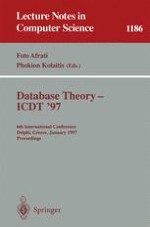This book constitutes the refereed proceedings of the 6th International Conference on Database Theory, ICDT '97, held in Delphi, Greece, in January 1997.
The 29 revised full papers presented in the volume were carefully selected from a total of 118 submissions. Also included are invited papers by Serge Abiteboul and Jeff Ullman as well as a tutorial on data mining by Heikki Mannila. The papers are organized in sections on conjunctive queries in heterogeneous databases, logic and databases, active databases, new applications, concurrency control, unstructured data, object-oriented databases, access methods, and spatial and bulk data.
